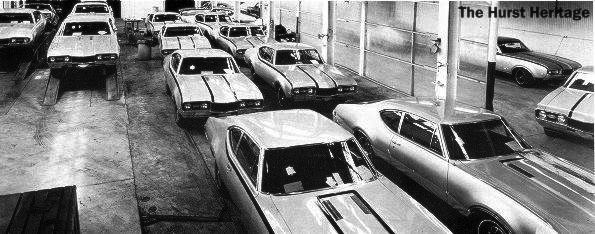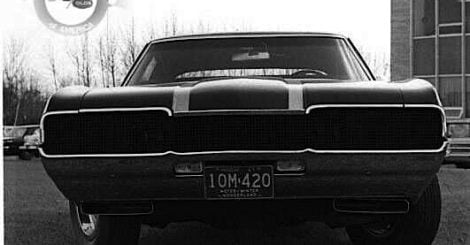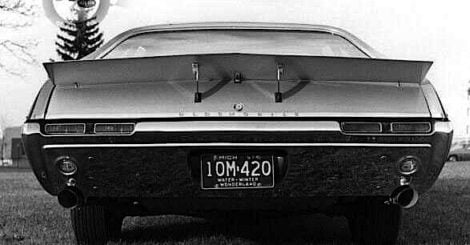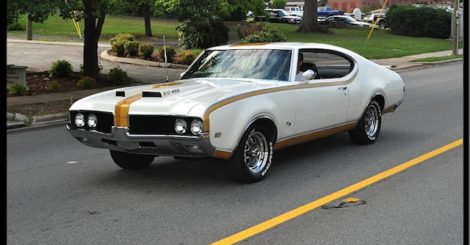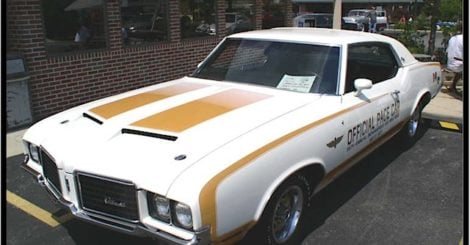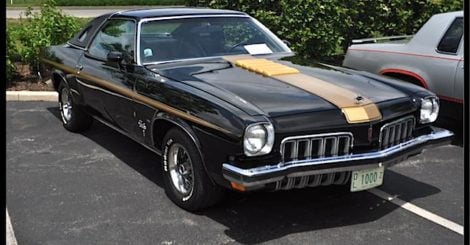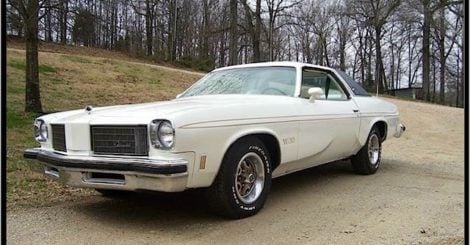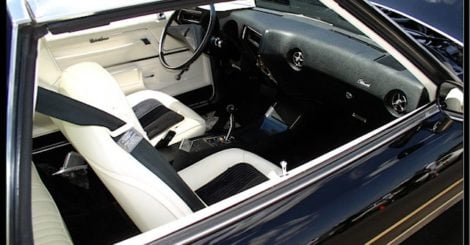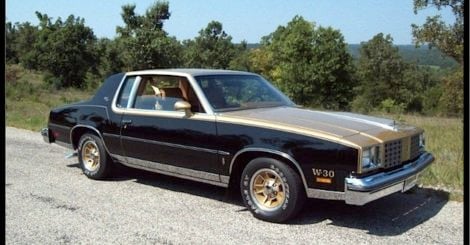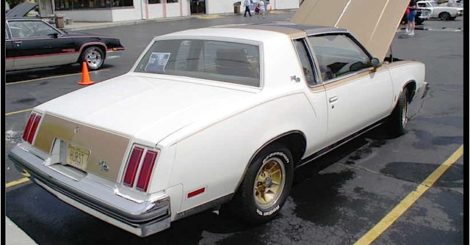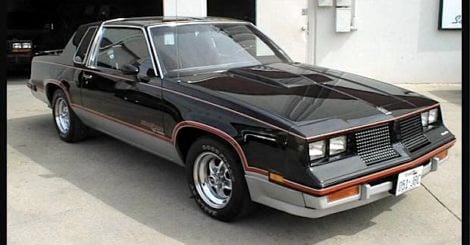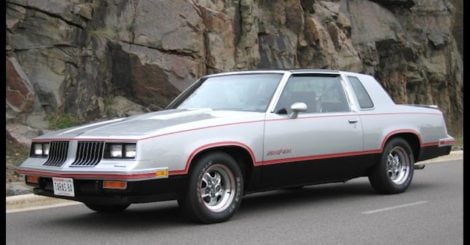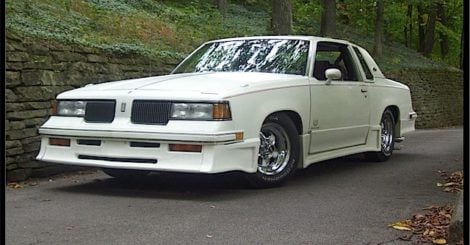When it comes to subversive behavior by an automaker, the first example that comes to mind is the Pontiac GTO. GM had a rule that none of their mid-size cars could have a motor bigger than 330 cubic inches. For Pontiac, that meant the relatively new 326 was as big as it got for the Tempest/LeMans, but a loophole and some creativity got the big 389 through as part of an optional package. With Chevrolet, they put 427s in Camaros and Chevelles with the Central Office Production Order (COPO), a channel normally used for fleet and special orders that went beyond the Regular Production Order (RPO) process available to the general public.
But there is one other GM brand that bucked the system and, in the process, created a lineage of special edition machines that continue to resonate with enthusiasts to this day: The Hurst/Olds.
The 1968 Hurst/Olds prototype. Note the collapsible spoiler.
Pennsylvanian George Hurst first became famous to performance fans for his shifters. When manual transmissions were still on the column, Hurst developed a kit to give you a more precise shifting from the floor. And when manufacturers started to offer floor shifts, Hurst was smart enough to convince some manufacturers to make Hurst OEM. Other hi-po equipment followed, solidifying the Hurst name as quality performance brand.
Even though Pontiac had the strongest association with Hurst in the mid-1960s, that would soon change with the introduction of the redesigned Oldsmobile 4-4-2 for 1968. That was the year Olds redesigned the 400 from a large-bore motor with the 425’s stroke to a small-bore motor with the 455’s stroke. To many, this was not considered an improvement, and no one realized this more than George Hurst. Not only did he swap in a 455 from the Toronado, but he found the extra horsepower also came with a nice benefit – less weight. He proceeded to personalize his ride with a new paint job and obligatory Hurst Dual/Gate shifter, among other items.
Knowing a good opportunity, he tried to sell Oldsmobile his idea of an adult supercar. Oldsmobile’s John Beltz ran with the idea and commissioned Lansing-area firm Demmer Engineering to convert 500 (later amended to 515) 4-4-2s into Hurst/Oldses.
Interestingly, even though the H/O required the installation of the 455 – against GM’s edict – the motor was installed on the assembly line and not at Demmer’s facility as was previously believed. All were Peruvian Silver (a Toronado color) and Ebony Black with black stripes, 455/390 with the W-30’s Force-Air Induction and red plastic fender wells, and heavy-duty automatic connected to – naturally – a Hurst Dual/Gate shifter.
(Left) The 1969 H/O was about as wild as it got for 1969. The H/O returned for 1972, now based on the notchback Cutlass Supreme. This one has pace car regalia.
A rousing PR success, Oldsmobile teamed up with Hurst for another go at it for 1969. This time the pendulum swung the other way, from the understated maturity of 1968’s to balls-to-the-wall for 1969. There was nothing subtle about the Hurst/Olds with its Cameo White paint and Hurst Fire Gold highlights, “mailbox” hood scoops, and spoiler that would have made Neil Armstrong envious. Horsepower was down to 380, but otherwise it was the same under the hood. Two convertibles and 912 hardtops were built.
A Hurst/Olds was proposed for 1970, but Olds decided to steal Hurst’s thunder and and produce the “Junior Supercar” Rallye 350 instead. By that time, the supercar market was declining, and GM’s lowering the compression of all its 1971 engines was the kiss of death, so Hurst concentrated on other endeavors. However, after the pace car accident at 1971’s Indy 500, Hurst saw an opportunity to restart its partnership with Oldsmobile and be Indy’s pace car for 1972.
The revamped H/O was now based on the Cutlass Supreme hardtop or convertible, and the former was available with a sunroof. Again, it was white and gold with a 455 (270 net horses or 300 with the W-30 package), but emphasis now shifted from in-your-face performance to wild-yet-mild luxury. Two-hundred twenty were hardtops with sunroof, another 279 without sunroof, and 130 convertibles were built. A handful of Hurst/Olds Vista Cruisers were also built for racetrack duties.
For the first time, black was added as an available choice.
Despite 1972’s low production, it was only natural for Hurst to capitalize on the increasing maturity of performance-oriented buyers. While horsepower had decreased at an alarming rate due to regulations from Washington, cars like the Monte Carlo, Grand Prix, and even Oldsmobile’s own Cutlass Supreme were more popular than ever, there were a few people who desired exclusivity with their personal luxury.
 [8]
[8]The H/O was available with two engines for the first time, and once again it was chosen to pace the Indy 500.
So when Oldsmobile redesigned the Cutlass for 1973, the Hurst/Olds returned even more luxurious than ever. Now available in white/gold or black/gold, the 455 and an automatic was still the only way to go for buyers. While power was down from the 1960s, it still was about as fast as anything out there save a Super Duty Firebird. An inviting interior and heavy-duty suspension made this the most comfortable and best handling H/O yet. Production shot up to 1,097.
The 1974 Cutlass was heavily facelifted, giving it a look that would last for a few more years as the Cutlass Supreme in particular became America’s most popular car. New this year was the option for a 350, which was called the W-25; the 455 continued to be available and was now referred to as the W-30, although it had nothing in common with the W-30 performance package before emissions took over. Same color choices as before, but the big news was the selection of the H/O to be pace car at the Indy 500 once again. Production increased to 1,800.
The 1975 H/O was pimpin'!
Nineteen seventy-five continued with the same formula as before, but now the Hurst/Olds was available with T-tops – specifically, the Hurst/Hatch. But despite production reaching an all-time high of 2,535, this was the end of the line for the H/O. Why is anyone’s guess, but Hurst returned to the fold for 1979 with Oldsmobile’s new-gen Cutlass, a downsized car that lost none of its substance. For the first time, this creation came completely from Lansing without a production assist from Hurst. Another first was the lack of availability of a 455 as the Oldsmobile 350 was the only engine available (and the only GM G-body to have a motor as big), although the H/O was adorned with W-30 decals. Same available colors as before, and sales were around the same as before at 2,499.
The H/O returned for 1979, now on the downsized Cutlass.
And then, again, a respite of sorts. During these extra-lean years, GM introduced their X-cars with front-wheel drive, and even the Corvette ended up skipping a model year in 1983. But that was the same year the Hurst/Olds returned. It basically was the same car as before but with Oldsmobile’s updated styling and a smaller version of the Olds small block, the 307; with some massaging, it put out 180 horses with a four-barrel carb. All H/Os were 15th Anniversary Editions in black with silver and red trim and came with Hurst’s Lightning Rod automatic shifter and 3.73 gears. After 3,000 built, it returned for 1984 in identical form aside of the inverse color scheme of silver with black and red trim. Another 3,000 were built, and that was it for the Hurst/Olds as Oldsmobile decided to revive the 4-4-2 package.
The 1983-84 were identical aside of inverse paint scheme. About 3000 of each were built.
But in 1988, during the swan song of the rear-wheel drive Cutlass, Hurst commemorated the 20th anniversary of the original Hurst/Olds by offering an aero kit that could be installed on any 1981-88 Cutlass, although only those installed on 1988 cars were considered 20th Anniversary models while the other ones were known as Hurst/Aeros. It is not known how many kits were built.
Have you ever seen a 1988 Cutlass with the H/O Aero kit?
Hurst had associations with other manufacturers – for example, Hurst created the SC/Rambler and the Pontiac Grand Prix SSJ – but it’s their legacy with Oldsmobile that is most remarkable. George Hurst’s aftermarket and OEM products have always made good cars better, and nowhere else is this apparent than with the cars from Lansing, Michigan.
